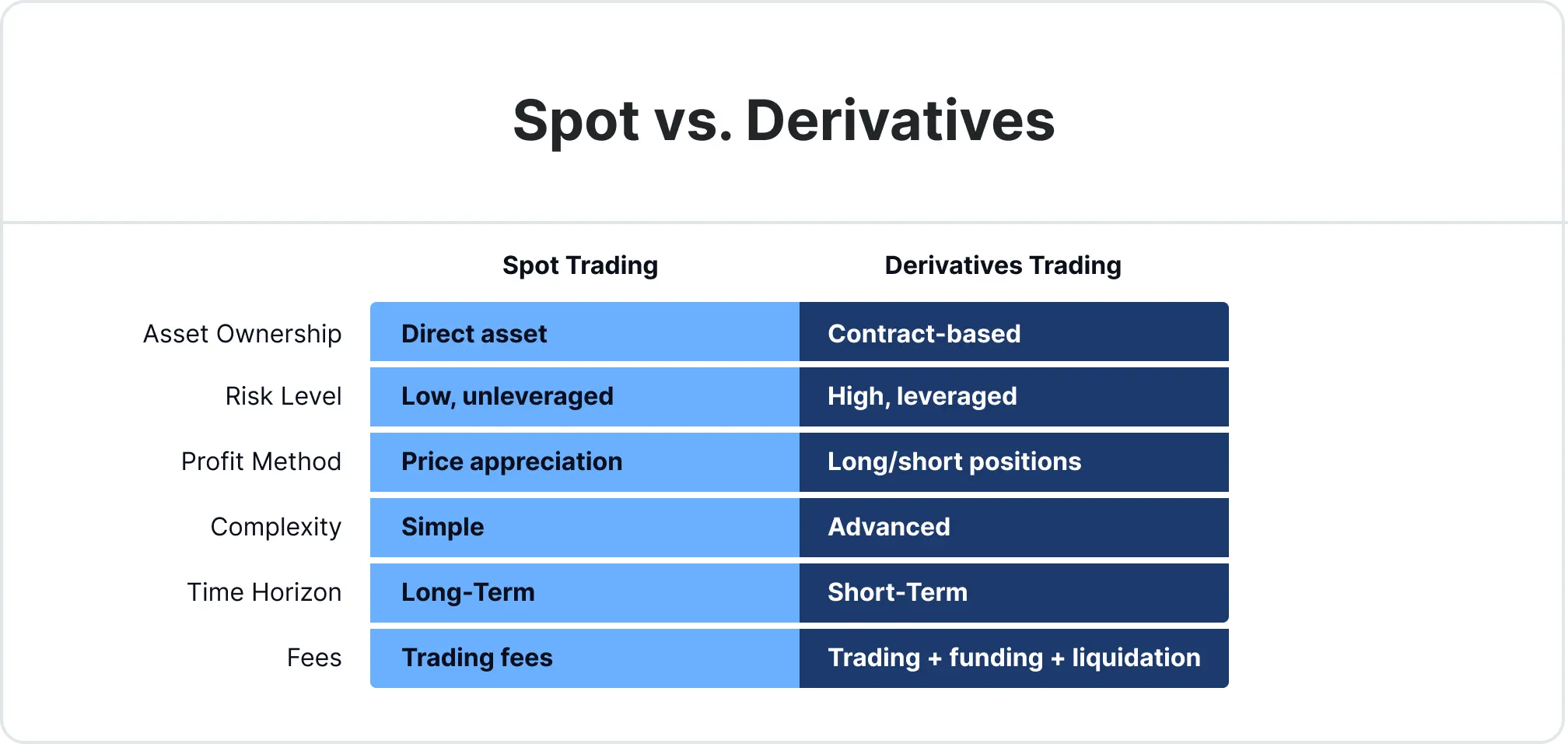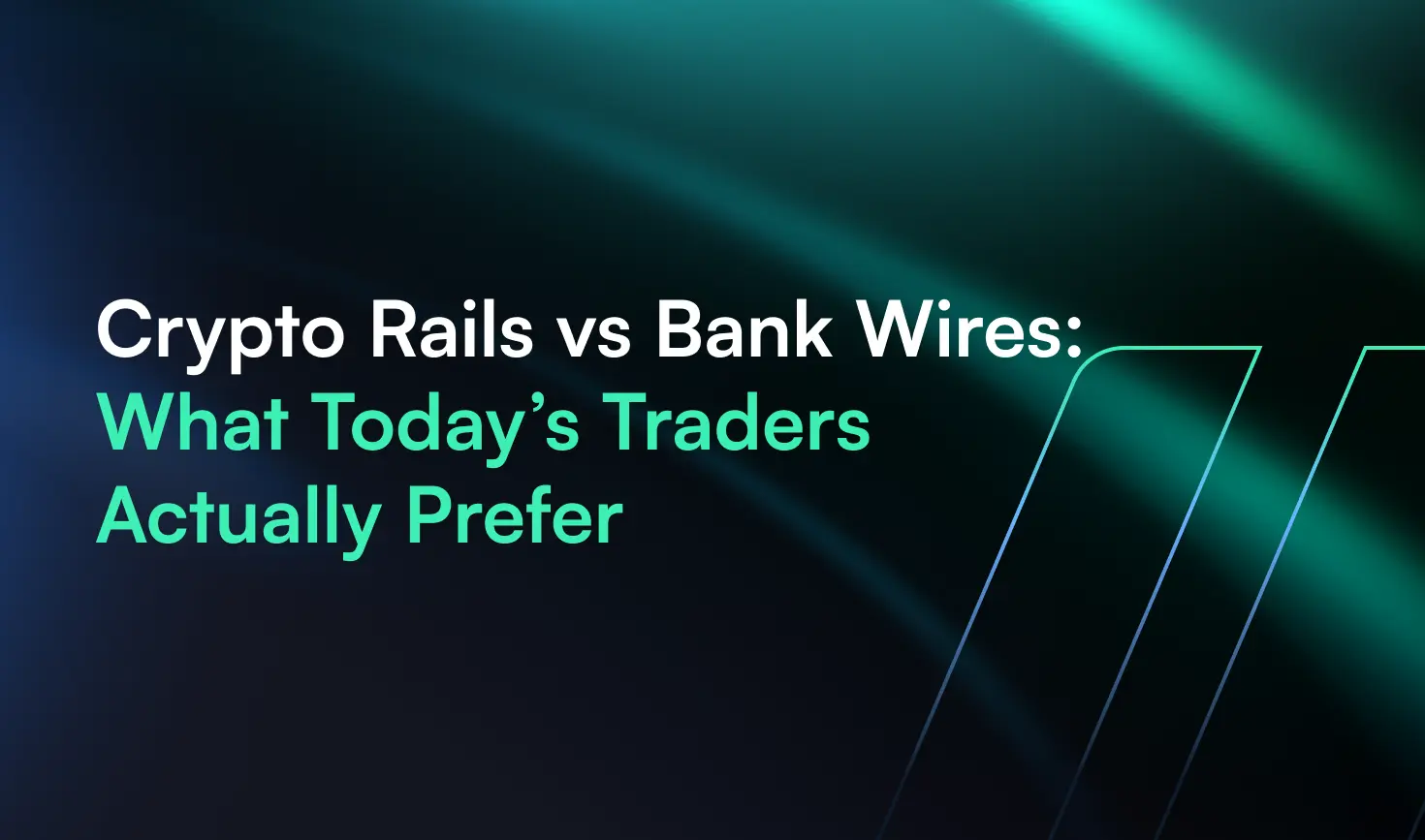Summarize with AI:
Updated May 3, 2025
Key Takeaways:
-
Spot trading involves directly purchasing and owning cryptocurrencies, providing simplicity and transparency.
-
Derivatives trading uses contracts based on the value of cryptocurrencies, offering flexibility and leverage.
-
Ideal for long-term investors, spot trading offers lower risk and direct asset ownership.
-
Experienced traders can profit from market fluctuations in both directions with derivatives trading, utilizing advanced strategies.
Spot vs. Derivatives Trading in Crypto: What’s the Difference?
The cryptocurrency market continues to grow in 2025, attracting both long-term investors and active traders. Among the core trading mechanisms that dominate digital asset markets are spot trading and derivatives trading. While both offer exposure to cryptocurrencies, they operate on entirely different principles and cater to different strategies, timeframes, and risk appetites.
Understanding how these trading types work is critical for anyone seeking to navigate today’s fast-paced, highly liquid, and increasingly complex crypto landscape.
What is Spot Trading in Crypto?
Spot trading in crypto refers to the direct purchase and sale of cryptocurrencies for immediate delivery. When engaging in spot trading, investors buy a specific amount of cryptocurrency, such as Bitcoin or Ethereum, which is then transferred to their digital wallet. This method allows traders to own and hold the actual asset, providing the flexibility to use it as they see fit.
Spot trading typically takes place on exchanges that operate around the clock, offering real-time transactions. Its a straightforward approach that is favored by those who prefer to hold their investments long-term, benefiting from potential price appreciation over time.
Benefits of Trading Spot
Spot trading offers several advantages for cryptocurrency investors:
- Ownership: By purchasing cryptocurrencies directly, traders own the actual digital assets, allowing them to hold, transfer, or use them as they wish.
- Simplicity: Spot trading is straightforward and easy to understand, making it accessible to both new and experienced traders.
- Lower Risk: Since traders only invest what they can afford to buy, the risk is generally lower compared to leveraged trading methods.
- Liquidity: Major exchanges provide high liquidity for spot trading, ensuring quick and efficient transactions.
- Transparency: Prices in spot trading reflect the current market value of the asset, providing a clear and transparent trading environment.
What is Derivatives Trading in Crypto?
Derivatives trading in crypto involves buying and selling contracts whose value is based on the price of an underlying cryptocurrency without actually owning the asset itself. These financial instruments, such as futures, options, and perpetual contracts, allow traders to speculate on the price movements of cryptocurrencies.
Derivatives provide opportunities to profit from both rising and falling markets, offering greater flexibility and potential for sophisticated trading strategies. This type of trading is typically conducted on specialized exchanges and often involves leverage, enabling traders to control larger positions with a smaller initial investment. While derivatives trading can lead to significant profits, it also carries higher risks, making it suitable for experienced traders who understand the market dynamics and risk management.
Types of Derivatives Trading
Derivatives trading in crypto encompasses various financial instruments, each offering unique ways to speculate on the price movements of cryptocurrencies. These instruments include margin trading, options, and futures, among others, each designed to cater to different trading strategies and risk appetites.
-
Margin trading: Use of borrowed funds to increase trade size, amplifying both gains and losses.
-
Options: Contracts granting the right (not obligation) to buy or sell crypto at a specific price before expiry.
-
Futures: Standardized contracts to buy or sell a cryptocurrency at a predetermined price on a future date.
Benefits of Trading Derivatives
Trading derivatives in crypto offers several significant advantages:
- Leverage: Traders can control larger positions with a smaller amount of capital, amplifying potential returns on investments.
- Flexibility: Derivatives provide the ability to profit from both rising and falling markets, making them suitable for various market conditions.
- Hedging: Investors can use derivatives to hedge against potential losses in their spot holdings, managing risk more effectively.
- Access to Advanced Strategies: Derivatives enable the use of sophisticated trading strategies, such as options spreads and futures arbitrage, which can enhance profitability.
Core Differences Between Spot and Derivatives Trading

The primary distinction between spot and derivatives trading lies in the ownership of the asset. In spot trading, investors buy and hold the actual cryptocurrency, giving them direct ownership and control over their assets. Conversely, derivatives trading involves contracts based on the value of the underlying cryptocurrency, allowing traders to speculate on price movements without owning the asset itself. This fundamental difference influences the risk and reward profiles of each trading strategy.
Spot trading is generally simpler and carries lower risk, making it suitable for long-term investors. In contrast, derivatives trading offers higher potential returns through leverage but comes with increased complexity and risk. Additionally, derivatives trading provides more flexibility, enabling traders to profit from both rising and falling markets, whereas spot trading primarily benefits from price appreciation.
Choosing the Right Trading Strategy
Deciding between spot and derivatives trading comes down to your investment goals, risk tolerance, and experience level. Spot trading is well-suited for those who prefer a straightforward, lower-risk approach with direct ownership of cryptocurrencies. It offers transparency, simplicity, and is ideal for long-term investors looking to hold assets without the complexity of leveraged positions.
In contrast, derivatives trading is geared toward more experienced traders who are comfortable managing higher risk in exchange for greater flexibility. By using leverage, traders can control larger positions and profit from both rising and falling markets. This approach supports a range of advanced strategies, but it also demands deeper market understanding and active risk management. Ultimately, selecting the right strategy means aligning your trading style with your financial objectives and comfort with volatility.
Conclusion
In conclusion, both spot and derivatives trading offer unique advantages and cater to different types of investors in the cryptocurrency market. Spot trading is ideal for those who prefer simplicity and direct ownership, while derivatives trading provides opportunities for leverage and sophisticated strategies.
By understanding the core differences and benefits of each method, you can make more informed decisions and choose the trading strategy that best aligns with your financial goals and risk tolerance. Whether you are a novice or an experienced trader, knowing these distinctions will enhance your ability to succeed in cryptocurrency trading.
For those looking to build a robust derivatives trading infrastructure, reach out to Shift Markets today. Our premier exchange software offers the tools and support you need to succeed in the competitive crypto market.
Shift Markets is not a financial advisor, and the information provided in this article is for educational purposes only. Always conduct your own research and consult with a professional financial advisor before making any investment decisions.
Share this article:
Want to learn more?
Let us save you time by walking you through what Shift can do for your business!



